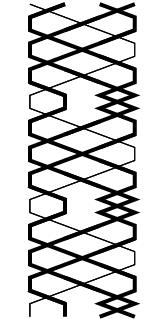
Plain Bob

Plain Bob
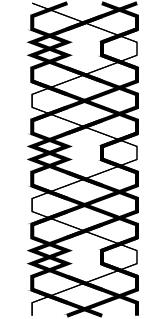
Reverse Bob
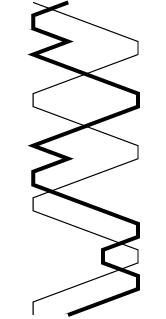
Reverse Bob
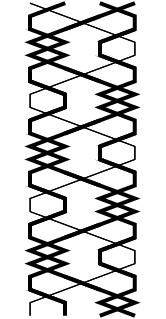
Double Bob
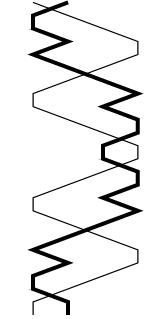
Double Bob
The Tower Handbook
Many methods are a little more complex than Plain Bob but not too difficult. They are worth learning for their own sake as well as being a useful step before moving on to more advanced methods like Surprise. Some are related to each other so you can often learn them as variants of each other. Learning different methods like this will help you develop a more flexible and rounded way of thinking about different methods that you should find helpful later.
As you start to ring methods more complex than Plain Bob, it becomes more useful to know more about what is going on and how things fit together. It is useful to know where the treble is (as opposed to merely knowing where you pass it) and that when you do one piece of work with a bell you will meet the same bell a little later. Each piece of extra information helps you to ring the method more reliably. Many people find that by learning the structure [183], they have less difficulty remembering the method, so if called to ring it after some time without doing so, they are less likely to have to dive for their diaries and look sheepish when the tower captain says 'We all learnt this two months ago'. When you learn the method, use some squared paper (as recommended in 6.6n) and draw out the structure, either working from the figures or carefully copying out all the place bells. [184]
There are several. The table below describes a few of the commoner ones in terms of how they differ from Plain Bob
| Method | Relation to Plain Bob | Interesting features |
| Little Bob (any number) | Leads as Plain Bob. Extra dodges when treble makes 4ths. Coursing order throughout as Plain Bob. | Can be learnt as a variant of treble bobbing, but important to learn difference between lead end and half lead dodges. |
| St Clements (any number) | Structure under the treble split in two giving long dodges on the front and lots of hunting down to 3rds. Coursing order is like Plain Bob but with the pair dodging on the front missed out. | Lead end order is reversed. Dodging on the front requires stable rhythm or the pair can become detached from the rest. Need to count how many dodges on the front and/or reliably see the treble coming down. |
| Single Oxford (Minor and Triples) | Structure over the treble split in two giving long dodges on the back and what looks like Plain Bob (or Grandsire for Triples) on two fewer bells below. Coursing order mixed up except on the back. | Need to remember to make the place before the dodge 3-4 (or 4-5) down. Need to count how many dodges on the back and/or reliably see the treble coming up. |
| Single Oxford (Major and higher) | It has extra pairs of places for (even longer) sets of dodging, with the work below as on two fewer bells. Coursing order more mixed up. | As above. Need to remember to make the place before each additional long dodge away from the back. |
| Double Bob | Plain Bob above the treble and Reverse Bob below. | Progression through the work is as Plain Bob, if you include the work under the treble in terms of its mirror image. The work comes twice as fast. |
| Kent Treble Bob (any number) | One bell in the slow makes repeated 2nds. All others do treble bob hunting except on the front and just before and after the lead in 3-4 which is replaced by Kent places [185] Coursing order as Plain Bob without the slow bell. | Need to remember to make 3-4 places when the treble is below you. Need to go in and out of the slow when you dodge with the treble. Need better bell control for almost continual dodging. |
Many other methods are suitable for this stage of learning, but we cannot list them here. What you have a chance of ringing will depend on the traditions in your tower and the other towers you visit. A competent ringer can learn many of these methods quite quickly, so you are more likely to be able to persuade enough people to ring one, say at a ringing meeting. Whatever method you ring, try to find out what its distinguishing features are as we have done in the table.
It is what you get if you turn everything in a method front to back (first place to last place). The work under the treble is a mirror image of the work over the treble in the original method, and vice versa. The blue line is a front to back mirror image of the original, but the starting positions move half a lead so the treble still starts in first place. Reverse methods are named Reverse X where X is the method that is the method they are derived from. The one exception is Reverse Bob which would logically be called Reverse Plain Bob. It is illustrated below.
The diagrams show three Minimus [186] methods: Plain Bob, Reverse Bob (and Double Bob for the next question). Each is drawn in two different ways. The first set shows the line of every bell. This makes it easier to see how the whole structure is mirrored and work fits together. The second set just shows the blue line of a single bell so you can see reflection in the line.
 Plain Bob  Plain Bob |
 Reverse Bob  Reverse Bob |
 Double Bob  Double Bob |
A double method has work under the treble that is a mirror image of the work over the treble. Its blue line is a back to front mirror image [187] of itself.
Common examples include: Double Bob, Double Court, Double Oxford (and more complex methods like Superlative and Bristol Surprise). Double Bob Minimus is shown in the diagrams above. Double Oxford Minor is shown right, along with Single Oxford for comparison.
Double methods can be easier to learn. A quarter of the blue line can be reflected end to end and front to back to obtain the other three quarters.
Of course if you learn like this, you may make more mistakes. Things often feel different when you are ringing them backwards or upside down! If you find yourself saying '3-4 places' when you are ringing an upside down bit of Major in 5-6, you can confuse yourself.
This approach probably works best if you learn your methods pictorially, but even then you may still find problems.
 Single Oxford |
 Double Oxford |
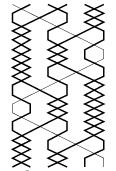 Compare Double and Single Oxford above. Would you have predicted the appearance of the 3-4 places which form a neat piece of work and do not appear in the original method? Look at the diagram of the structure (right) to see how this happens.
Compare Double and Single Oxford above. Would you have predicted the appearance of the 3-4 places which form a neat piece of work and do not appear in the original method? Look at the diagram of the structure (right) to see how this happens.
Also, would you have expected that the whole plain course consists of slowly working your way from front to back to front again only once?
Learn methods fully to avoid nasty surprises.
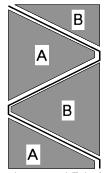 It is a way of describing methods that are in fact hybrids of two other, often more well known methods. Imagine you had drawn out a lead and a half of two different methods [188] (as suggested above, but with all lines the same colour except the treble). If you cut the paper along the treble path in each of them, you will have triangular [189] pieces of paper for the work over and under the treble in the two methods. Now stick together the under pieces from one method and the over pieces from the other. You have created a new method [190] which can be described as A under the treble and B over the treble (sometimes referred to as below and above the treble).
It is a way of describing methods that are in fact hybrids of two other, often more well known methods. Imagine you had drawn out a lead and a half of two different methods [188] (as suggested above, but with all lines the same colour except the treble). If you cut the paper along the treble path in each of them, you will have triangular [189] pieces of paper for the work over and under the treble in the two methods. Now stick together the under pieces from one method and the over pieces from the other. You have created a new method [190] which can be described as A under the treble and B over the treble (sometimes referred to as below and above the treble).
If you can ring say four methods (of the same type), the number of new methods that could be made by mixing them over and under may be up to twelve new ones, ie sixteen in all [191]. If you understand the structure of the methods you already ring, or if you know what to do in terms of where you pass the treble (up and down) then you could ring any of these twelve complete new methods with a modest extra effort. Think of the effort you would need to learn twelve new blue lines.
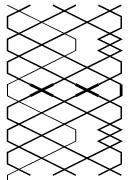 Most common methods have 2nds place made at the lead end change. If a method had 6ths place [192] instead of 2nd place, it would become a different method, and yet the actual difference is tiny. The difference is no more than the difference between a bob and a plain lead.
Most common methods have 2nds place made at the lead end change. If a method had 6ths place [192] instead of 2nd place, it would become a different method, and yet the actual difference is tiny. The difference is no more than the difference between a bob and a plain lead.
You can ring this new method without learning any more than what to do at the lead end change, providing you know all the starts (place bells) of the basic method. The 6ths place version of Little Bob is shown right.
If you wish to ring methods spliced then you must learn them by place bells as the change over from one method to the next takes place at the point where you become a new place bell [193], and you must pick up the new method from there.
We described course and after bells under learning simple methods, see 13.8k. Knowing about coursing order is an extension of that. In plain hunting, the bells follow each other to the back and front in sequence. In a plain hunt the order always stays the same but in Plain Bob it changes because of what happens at the lead. But if you ignore the treble in the sequence, then the other bells still keep in the same order during every lead of Plain Bob. This sequence without the treble is what we normally mean by the coursing order.
When you started ringing methods you were probably told not to learn the numbers. This was good advice because it made you focus on other ways of seeing where you were, and made you less dependent on individual bells, who may themselves go wrong. As you become more experienced, it is worth learning more about coursing order because it can help you sort out mistakes, both your own and perhaps someone else's as well. If you know in what order you expect to meet the other bells, it provides another check on what is happening and whether all is well. If you or someone else go wrong, knowing the coursing order may help put things back together.
The coursing order [194] of a plain course follows a simple pattern - down the odds and up the evens. On six bells it is 53246, on eight it is 7532468 and so on. Notice that the middle portion stays the same when more bells are added. The order is cyclic, so first follows the last. Work it out on paper if you are not sure. Plain Bob is very orderly. You can see the coursing order continually as you pass the bells throughout the whole course.
In more complex methods the order gets scrambled up, because the bells don't spend most of their time just hunting up and down, but it is easily visible some of the time and it is quite common for bells to come on the back in the same order. By convention, the coursing order is defined in terms of the lead head. In the plain course, starting with rounds (12345678.....), the coursing order is 2_4_6_8_.......7_5_3. For any other course, you merely apply the same transformation (up the evens and down the odds) to the positions in the lead head. So the coursing order in a course with lead head 143526 is 4_5_6_2_3 (rearranged cyclically if you prefer). By convention this is rearranged to start with the tenor, ie 62345, and the tenor is then normally omitted, ie just 2345.
You can do, and if you are just watching from lead to lead, it will work OK for you. But it is more normal to describe the coursing order starting from (but omitting) the tenor. If you do this and you are not ringing the tenor, you may be puzzled about how you can pass yourself. The answer is that whenever you reach the back or the front, you count your own bell number in the sequence.
Every call changes the coursing order, so if you are following it you must pick up the new order by noting when you meet the other bells. You can also work it out using simple rules. See section 13.11i.
You should know how to use passing the treble as a landmark in Plain Bob. These landmarks come during the long stretches of hunting between leads. In more complex methods work occurs at other parts of the lead, so you may meet the treble in the middle of pieces of work. Also knowing where the treble is at any time can give you reminders about what to do should your memory fail you for a second.
Have a look at the list of things to help ring advanced methods confidently (see section 13.10t). The list probably looks formidable when you first venture beyond Plain Bob, but don't panic. You don't have to do it all at once, which is why it is in the section on advanced methods, but you should be aiming in that direction. Try to use some of the techniques listed, and as you become more confident try a few more.
Currently hosted on jaharrison.me.uk